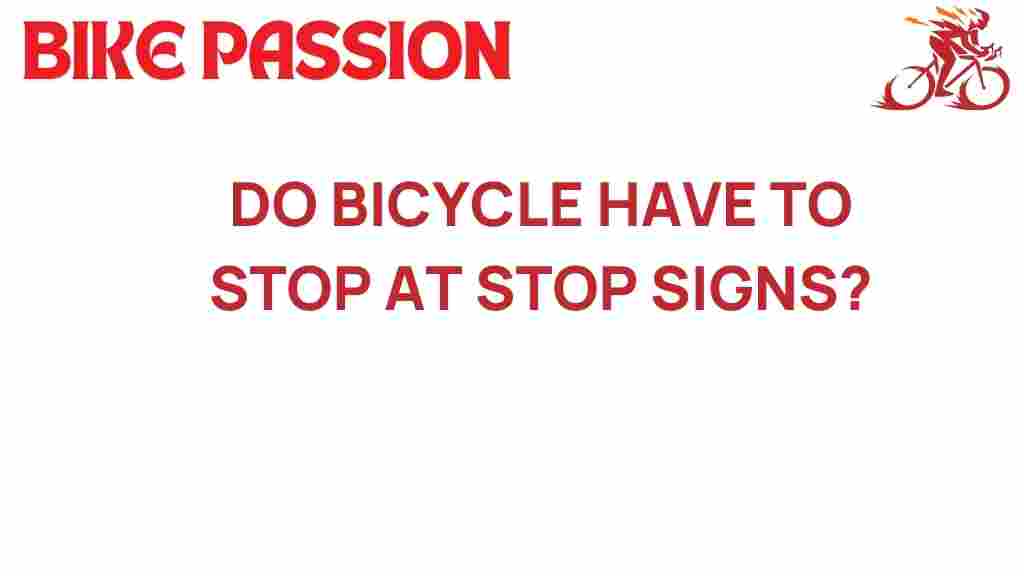Do Bicycles Really Need to Stop at Stop Signs?
Bicycles are a popular mode of transportation, especially in urban areas where traffic congestion is common. However, as cyclists navigate the streets, one question often arises: do bicycles really need to stop at stop signs? This article will explore the traffic laws surrounding bicycles and stop signs, consider cyclist rights, and examine how to ensure cycling safety while adhering to road rules. Let’s unravel these rules and understand the legal obligations for cyclists.
Understanding Traffic Laws for Bicycles
When it comes to bicycles and stop signs, the traffic laws can vary significantly from one location to another. In general, bicycles are considered vehicles in most jurisdictions, which means that cyclists are subject to the same traffic laws as motor vehicle drivers. Here are some key points to consider:
- Legal Obligations: Cyclists are legally required to obey all traffic signs, including stop signs, in many areas.
- Right of Way: Just like cars, bicycles must yield the right of way when necessary, especially at intersections.
- Local Regulations: Some cities have specific regulations that allow cyclists to treat stop signs as yield signs under certain conditions.
Variations in Laws Across Regions
Before riding, it’s crucial for cyclists to familiarize themselves with local bike regulations. For example, in some states in the U.S., such as Idaho and Delaware, laws allow cyclists to proceed through stop signs if the way is clear, effectively treating them as yield signs. However, this is not the case everywhere, and cyclists must be aware of the laws specific to their area.
Cycling Safety and Stop Signs
Safety should always be a priority for cyclists. While some jurisdictions may allow bicycles to treat stop signs differently, it is essential to consider the implications for cycling safety. Here are some tips to ensure safe cycling practices:
- Always Be Aware: Keep an eye on your surroundings and watch for vehicles, pedestrians, and other cyclists.
- Communicate Clearly: Use hand signals to indicate your intentions to other road users.
- Slow Down: Reducing speed when approaching a stop sign gives you more time to react to potential hazards.
How to Approach Stop Signs on a Bicycle
When approaching a stop sign, cyclists should follow a systematic approach:
- Observe: Look for traffic and pedestrians before reaching the stop sign.
- Decide: Determine whether to stop completely or proceed with caution based on local laws.
- Signal: If you’re turning, signal your intention to other road users.
- Proceed: If it’s safe, either stop fully or yield and continue through the intersection.
Common Misconceptions About Bicycles and Stop Signs
There are several misconceptions that can lead to confusion regarding bicycles and stop signs:
- All cyclists must stop: While many areas require cyclists to stop, others allow them to yield.
- Bicycles are not vehicles: Bicycles are classified as vehicles in most jurisdictions, and cyclists must obey the same laws.
- Stop signs are optional for cyclists: This is only true in specific areas where laws allow different treatment of stop signs.
Researching Local Laws and Regulations
It is vital for cyclists to stay informed about the laws in their area. Here are a few resources to help:
- Local Department of Transportation: Check for specific cycling laws in your region.
- Bicycle Advocacy Groups: Many organizations provide information on cyclist rights and safety tips.
Urban Cycling and Traffic Challenges
Urban areas often present unique challenges for cyclists, especially at intersections with stop signs. Here’s how to navigate these challenges effectively:
- Know Your Route: Familiarize yourself with the streets you ride on to anticipate stop signs and traffic patterns.
- Use Bike Lanes: Whenever possible, use designated bike lanes to improve safety and visibility.
- Be Predictable: Ride in a straight line and avoid sudden movements to help drivers anticipate your actions.
Dealing with Aggressive Drivers
Unfortunately, cyclists sometimes encounter aggressive drivers, especially at intersections. Here are some tips to handle these situations:
- Stay Calm: Avoid engaging with aggressive drivers; focus on your safety.
- Make Eye Contact: If possible, try to make eye contact with drivers to ensure they see you.
- Use Defensive Riding Techniques: Keep a safe distance from vehicles and be prepared to stop if necessary.
Troubleshooting Common Issues
Here are some common issues cyclists face regarding stop signs and how to resolve them:
Issue 1: Confusion Over Local Laws
Solution: Always check local laws regarding bicycles. The best way to remain compliant is to stay informed.
Issue 2: Drivers Not Yielding to Cyclists
Solution: Use hand signals to indicate your intentions and maintain a visible presence on the road.
Issue 3: Unsafe Intersection Designs
Solution: If you frequently encounter dangerous intersections, consider reporting them to local authorities for improvements.
Conclusion
In conclusion, whether bicycles need to stop at stop signs is a nuanced topic that depends on local traffic laws and cyclist rights. While many areas require cyclists to stop, others allow for a more lenient approach. Regardless of the laws, cycling safety should always be a top priority. Cyclists must be knowledgeable about the road rules, stay vigilant, and advocate for their rights on the road. By understanding their legal obligations and practicing safe riding, cyclists can contribute to a safer urban cycling environment.
For more information on cycling safety and rights, visit our Cycling Resources Page.
This article is in the category Routes and created by BikePassion Team
